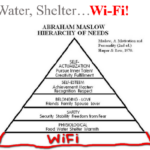Presence Analytics
When a Wi-Fi enabled device such as a smart phone or tablet comes within range of a wireless network, it sends a message called a “probe request” asking for the identity of the network. While probe requests are not used by most Wi-Fi networks if the client device does not associate or connect to the network, these simple transactions from un-associated client devices could yield important information. For example probe requests could be analyzed to determine how many people are nearby or walking by (passerby’s), how long the passerby hangs out (dwell), if they come inside the location (visitors), how many passerby’s vs visitors (capture rate), how long a visitor hang’s out (engagement) and if they are new or repeat visitors (loyalty). This brings the same type of metrics that are available to websites, to brick-and-mortar facilities.
There are numerous applications for foot traffic or Presence Analytics and even more being thought of daily. For example you could deliver relevant content, ads, services and offers to loyal visitors or visitors within proximity to something, determine effectiveness of new displays and marketing campaigns at a single site or across multiple, determine which sites or areas within a site are drawing the most traffic during which hours to staff accordingly, determine which areas of a building are occupied for public safety in an emergency or perhaps determine which areas of a building are occupied for an energy control system to proactively control lighting, heating and air conditioning to reduce energy costs.
Indoor Location-based Services
We are all familiar with GPS providing turn-by-turn directions to help us navigate from one location to another. The problem is, GPS only works outdoors or within the coverage zone of a satellite. It doesn’t work well indoors. The solution is location-based services provided (LBS) by Wi-Fi. LBS can be used by mobile devices to provide turn-by-turn directions inside schools, hospitals, malls, hotels, casinos, convention centers, stadiums, airports, train stations, subways, coffee shops, etc. Targeted content from analytics data such as presence/location, proximity to surroundings, demographics, device/OS/browser type, websites/applications and social media likes and interests could be leveraged to influence where the user goes and to push content to them as they navigate. Further this analytics data could be combined with data from 3rd party CRM, POS and advertising systems by leveraging APIs to deliver even more targeted content. Again the more targeted the content, the more effective. Like user journeys, location based services are a great platform for targeted advertising and can help underwrite the cost of the installation and generate and on-going revenue stream.
Imagine getting turn-by-turn directions throughout a museum and each exhibit or art piece being explained on your mobile device. Imagine the exhibits and pieces you like influencing your journey throughout the rest of the exhibit. Imagine digital signage and music updating to match your tastes and preferences. Imagine being offered a special on your favorite wine as you walk by the restaurant. Imaging being offered a quick and easy seating upgrade if the VIP seats aren’t filled. LBS promises all this and more and future enhancements such as 802.11revMC and Angle of Arrival promise to make it more and more accurate over time.
Check out part 3 of this 3 part blog series on Monetizing Wi-Fi where I’ll cover Application and Website Analytics, Social Media and conclude.







Recent Comments